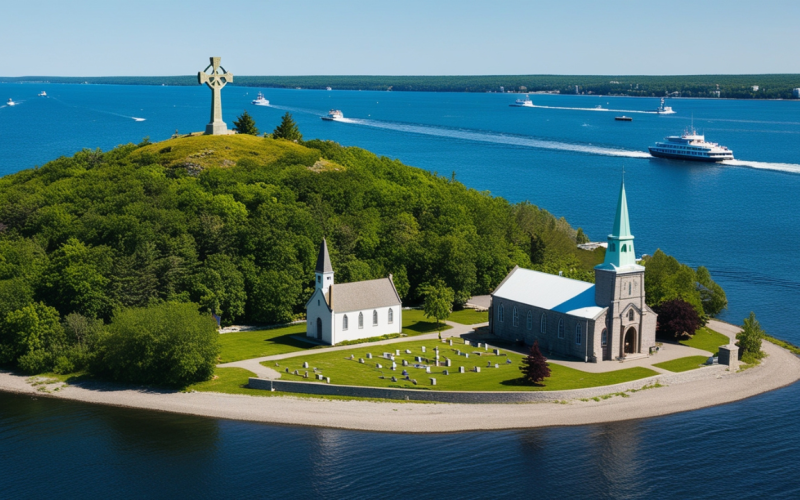intro of Grosse Île and the Irish Memorial National Historic Site (Quebec)
Grosse Île and the Irish Memorial National Historic Site (Quebec)is a place where history comes alive. This small island on the Lawrence River, just minutes from Quebec City, once served as a quarantine station for immigrants arriving in Canada from 1832 to 1937.
Managed by Parks Canada, it now stands as a poignant memorial to those who passed through its gates, particularly the Irish immigrants who fled the Great Famine.
As you walk through its historic buildings and visit the Irish Cemetery, you’ll uncover stories of resilience, hope, and loss. Grosse Île is more than just a historical site; it’s a connection to the millions who helped shape Canada.
Key Takeaways
- Grosse Île served as a quarantine station for immigrants entering Canada from 1832 to 1937.
- It honours the thousands of Irish immigrants who died during the Great Famine and epidemics like cholera and typhus.
- Visitors can explore landmarks such as the Irish Cemetery, Celtic Cross, and the disinfection building.
- The island offers guided tours and exhibits that tell the story of immigration to Canada.
- Accessible by boat or plane, Grosse Île is a must-visit for history enthusiasts.
The Historical Role of Grosse Île
Grosse Île as a Quarantine Station (1832-1937)
In the early 19th century, Canada was experiencing a massive influx of immigrants, particularly through the Port of Quebec. Grosse Île was established in 1832 as a quarantine station to manage the spread of infectious diseases like cholera.
For over a century, the island served as a point of entry for immigrants, ensuring public health while also acting as a gateway to Canada.
From 1832 to 1937, immigrants arriving at the Port of Quebec were examined and, if necessary, quarantined on Grosse Île. The station’s medical facilities were equipped to deal with outbreaks of typhus, smallpox, and other diseases brought by overcrowded ships.
The Impact of the Great Famine (1847)
The Great Irish Famine of 1845-1852 led to a surge in immigration to Canada, with 1847 being a particularly tragic year. Thousands of Irish emigrants arrived at Grosse Île, many suffering from typhus. The overcrowded conditions and lack of medical resources led to the deaths of thousands who were buried in mass graves on the island.
Today, the Irish Cemetery and Celtic Cross honour the memory of those who perished. The cross, erected in 1909 by the Ancient Order of Hibernians, stands as a powerful symbol of loss and resilience.
Life and Operations on Grosse Île
Facilities on the Island
Grosse Île was designed to handle large numbers of immigrants efficiently while minimizing the spread of disease. Key facilities included:
- Disinfection Building: Immigrants’ belongings were disinfected to kill bacteria and viruses. This was a critical step in disease prevention.
- Hospitals and Lazaretto: These buildings housed those who were sick. The lazaretto, in particular, was used for severe cases.
- Quarantine Wharf: Ships docked here, and passengers were inspected before entering Canada.
Frederick Montizambert, a prominent medical superintendent, modernized the island’s facilities in the late 19th century, introducing bacteriological methods to improve public health.
The Role of Religion
Religion provided comfort to those who endured long journeys and uncertain futures. The Catholic Chapel and Anglican Chapel on the island served as places of worship and refuge. Priests and ministers often conducted funeral services for those who died on the island.
Exploring Grosse Île Today
How to Get There
Grosse Île is accessible via boat or plane, making it a convenient day trip from Quebec City.
- By Boat: Croisières Lachance offers ferries from Berthier-sur-Mer, a small town on the south shore of the Lawrence River.
- By Plane: Flights are available from Montmagny, providing a bird’s-eye view of the Isle-aux-Grues Archipelago.
The journey itself is scenic, offering views of the river and surrounding islands.
Key Landmarks to Explore
Visitors can explore various landmarks that tell the story of Grosse Île:
- Irish Cemetery: A burial site for thousands of immigrants who died during quarantine.
- Celtic Cross: This iconic memorial was erected in 1909 to honour the Irish who died on the island.
- Disinfection Building: Learn about the measures taken to prevent the spread of diseases.
- Catholic and Anglican Chapels: Explore the spiritual sanctuaries that supported immigrants and workers.
Guided Tours and Interactive Exhibits
Parks Canada offers guided tours in French and English, providing in-depth insights into the island’s history. Interactive exhibits showcase artefacts, medical tools, and personal stories of immigrants who passed through Grosse Île. These experiences connect visitors to the human side of immigration history.
Facts and Figures About Grosse Île
| Fact | Details |
| Years of Operation | 1832 to 1937 |
| Immigrants Processed | Over 1 million immigrants passed through. |
| Major Epidemics | Cholera (1832), Typhus (1847). |
| Religious Structures | Catholic Chapel, Anglican Chapel. |
Lessons from Grosse Île
Honouring Immigrants Who Passed
The story of Grosse Île is a testament to the resilience and sacrifices of immigrants who sought a better life in Canada. The island serves as a memorial to their struggles, reminding visitors of the challenges faced by early settlers.
Relevance to Modern Immigration
Grosse Île’s history provides valuable lessons about compassion, public health, and the importance of welcoming newcomers. The parallels between historical and contemporary immigration make it a meaningful site for reflection.
Tips for Visiting Grosse Île
Planning Your Visit
- Best Time to Visit: Late spring through early fall, when tours and activities are fully operational.
- Duration: Allocate at least 4-6 hours to explore the island thoroughly.
Accessibility and Language
- Tours are available in both French and English.
- The island is wheelchair accessible, making it easy for everyone to visit.
What to Bring
- Comfortable walking shoes, as you’ll be exploring outdoors.
- A camera to capture the scenic beauty and historic landmarks.
- Snacks and water, as on-site options, may be limited.
Why Visit Grosse Île?
A Blend of History and Natural Beauty
Grosse Île offers a unique combination of historical significance and natural beauty. Surrounded by the stunning landscapes of the Isle-aux-Grues Archipelago, the island provides a serene setting to reflect on Canada’s immigrant history.
An Immersive Learning Experience
With guided tours, exhibits, and well-preserved landmarks, Grosse Île brings history to life. It’s an opportunity to learn about the challenges faced by immigrants and the efforts made to protect public health during a critical period in Canada’s development.
FAQs About Grosse Île and the Irish Memorial National Historic Site
Q1. What is Grosse Île, and why is it significant?
Grosse Île is a historic site in Quebec that served as a quarantine station for immigrants entering Canada from 1832 to 1937. It is significant because it processed over a million immigrants, including many Irish fleeing the Great Famine. It now stands as a memorial to those who lost their lives due to diseases like cholera and typhus.
Q. How do I get to Grosse Île?
You can reach Grosse Île by boat from Berthier-sur-Mer or by plane from Montmagny. Both options provide scenic views of the Lawrence River and the surrounding Isle-aux-Grues Archipelago. Croisières Lachance offers regular ferry services during the tourist season.
Q3. What are the main attractions on the island?
Key attractions include:
- The Irish Cemetery, where thousands of immigrants are buried.
- The Celtic Cross was a memorial erected in 1909.
- Historic buildings such as the disinfection building, lazaretto, and chapels.
- Guided tours and exhibits that provide insights into the site’s history.
Q4. What is the best time to visit Grosse Île?
The best time to visit is between May and October when the site is fully operational and weather conditions are favourable. Summer months offer the most activities and guided tours.
Q5. Is Grosse Île accessible for families and people with mobility challenges?
Yes, Grosse Île is family-friendly and accessible for visitors with mobility challenges. The guided tours are available in French and English, and the island has accommodations to ensure a comfortable experience for all visitors.
My Opinion
Grosse Île and the Irish Memorial National Historic Site is more than a place to visit; it’s a place to remember. It tells the stories of those who came before us, seeking a better future despite immense challenges. As you walk through its cemeteries, chapels, and historic buildings, you’ll gain a deeper appreciation for the resilience of immigrants and the importance of preserving their legacy.
Plan your trip to Grosse Île and connect with a piece of Canada’s history that continues to inspire and educate.





